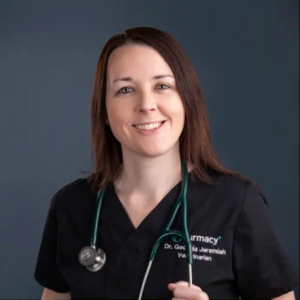A cat is considered to be obese when it is 20% above its ideal weight. Just like us humans, being overweight can shorten a cat’s life expectancy and increase the risk of heart conditions and diabetes.
If you are concerned about your cat’s weight, before making any changes with their diet, consult your veterinarian. They can assess your cat's overall health and provide tailored advice based on their specific needs.
It’s important to feed your cat a complete and balanced diet. Choose high-quality cat food that meets their nutritional requirements. Be mindful of portion sizes and avoid excessive treats.
Encouraging physical activity through play and interactive toys can also help keep your cat’s weight down. Toys that dispense treats can make mealtime more engaging and promote movement too.
Instead of free-feeding, establish a regular feeding schedule. This helps in controlling portion sizes and prevents overeating.
In some cases, your veterinarian might recommend a special weight-loss diet. These diets are formulated to help cats lose weight safely. See our list of the best cat food for weight loss below:
Our top picks
- Blue Freedom (Dry) Jump to review
- Solid Gold (Dry) Jump to review
- Hill’s Science Diet (Wet) Jump to review
- Optimeal (Dry) Jump to review
- Blue Buffalo True Solutions (Dry) Jump to review
- Tiki Cat Born Carnivore (Dry) Jump to review
- Halo Holistic (Dry) Jump to review
- Nulo MedalSeries (Dry) Jump to review
-
Blue Freedom (Dry)
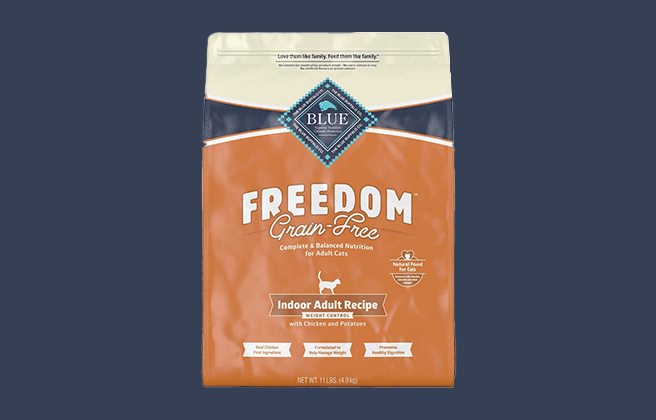
Blue Freedom Grain-Free Indoor Adult Recipe Weight Control with Chicken & Potatoes received the Cat Food Advisor’s highest rating: 5 stars.
It is one of five recipes in this product range made by Blue Buffalo, a company now owned by General Mills.
Blue Buffalo Freedom Grain-Free Indoor Weight Control recipe derives the bulk of its protein from chicken, which is naturally rich in the 11 essential amino acids required by a cat to sustain life.
Dry matter label analysis reveals a wet recipe containing 33% protein, 11% fat and 48% carbohydrates . . . with a fat-to-protein ratio of 33%.
This range is made up of five grain-free recipes which have high-quality natural ingredients such as real chicken, lamb, and beef and no artificial flavors or preservatives.
The Freedom dry range comes in a variety of flavors and is enhanced with vitamins and minerals. It also meets AAFCO standards.
Highly recommended.
Read our review of the full Blue Freedom (Dry) range hereThings we like
- Real meat as the main ingredient
- Supplemented with chelated minerals to help nutrient absorption
- Catered for indoor cats
Main Ingredients Deboned chicken, chicken meal, tapioca starch, peas, pea protein Texture Dry Type Nuggets Protein Percentage 33% AAFCO Standards Maintenance Best For Senior and adult cats Save up to 35%
with Autoship
See discount in cartSample buyer review...
"It's great for overweight cats; they don't even know the difference. They are tabby cats and they like Blue Buffalo products and I would recommend it to other people with kitties."
-
Solid Gold (Dry)
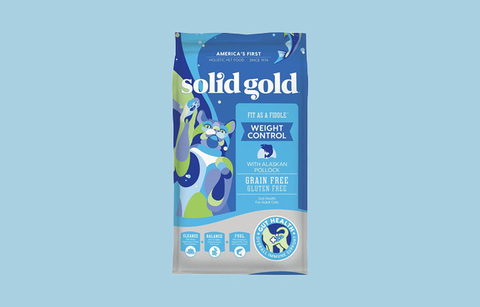
Solid Gold Fit as a Fiddle (Weight Control) With Alaskan Pollock received the Cat Food Advisor’s second rating: 4 stars.
It is one of nine recipes in this product range made by Solid Gold. A company founded in 1970 and manufactured by Diamond Pet Foods in the United States.
This weight control recipe derives the bulk of its protein from pollock, a protein-rich whitefish native to the central and northeast coasts of the United States.
Dry matter label analysis reveals a wet recipe containing 34.4% protein, 13.3% fat and 44.3% carbohydrates . . . with a fat-to-protein ratio of 39%.
Solid Gold dry cat food is made from nutrient-dense superfoods such as egg protein, pumpkin, cranberry, spearmint, carrot, apple, watercress, rosemary, lentil, celery, parsley, almond oil, beet, sesame oil, blueberry, broccoli, thyme, chicory root, dried kelp, spinach, and salmon oil.
Highly recommended
Read our review of the full Solid Gold (Dry) range hereThings we like
- Wide variety and high quality ingredients
- Added probiotics
- Recipes designed for specific dietary needs
Main Ingredients Pollock, turkey meal, peas, tapioca, chickpeas, pea fiber Texture Dry Type Kibble Protein Percentage 48% AAFCO Standards All Life Stages Best For Kittens, cats and senior cats Save up to 35%
with Autoship
See discount in cartSample buyer review...
"My picky fish eater and my not so picky kitty both love this food. They can’t stop eating it. Much less waste and my picky one is finally gaining weight. He was staying too slim for my comfort and the vet’s opinion, and no other food seemed to help him out before this. I highly recommend it for healthy weight, eyes and fur coats. Both seem to be improving in all areas in only a few weeks of starting the transition."
-
Hill’s Science Diet (Wet)
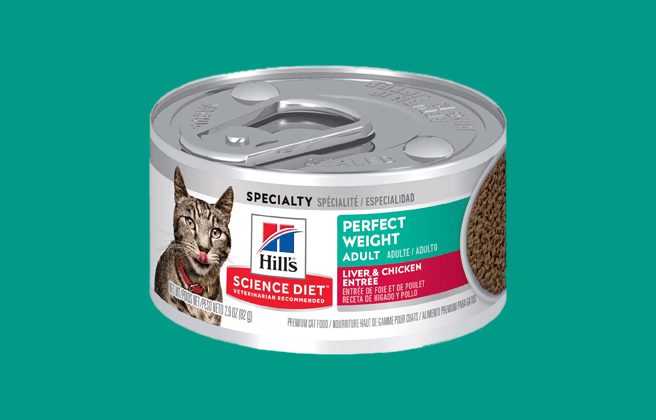
Hill’s Science Diet Adult Perfect Weight Liver & Chicken Entrée cat food received the Cat Food Advisor’s second highest rating: 4 stars.
It is one of 50 recipes in this product range made by Hill’s Pet Nutrition, a company founded in 1907.
Hill’s Science Diet Adult Perfect Weight Liver & Chicken Entrée Cat Food derives the bulk of its protein from pork which is naturally rich in all 11 essential amino acids required by a cat to sustain life.
Dry matter label analysis reveals a wet recipe containing 38.4% protein, 13% fat and 31.3% carbohydrates . . . with a fat-to-protein ratio of 34%.
Hill’s Science Diet cat food is known for using high-quality ingredients and focusing on balanced nutrition to support cats’ overall health.
It offers formulas tailored to meet the specific nutritional needs of all cats and specialized recipes to address certain health concerns, such as weight management, urinary health, hairball control, and sensitive stomachs.
Highly recommended.
Read our review of the full Hill’s Science Diet (Wet) range hereThings we like
- Science-led ingredients
- Wide range of products for different cats
- Quality protein ingredients
Main Ingredients Water, pork liver, pork by-products, corn flour, powdered cellulose Texture Wet Type Shreds Protein Percentage 38.4% AAFCO Standards Maintenance Best For Senior and adult cats Save up to 35%
with Autoship
See discount in cartSample buyer review...
"We have only just started using this brand, but my cats both seem to really love it! They lick their plates clean and ask for more. I like that it has healthy ingredients that they enjoy and it will help them both be at a healthy weight."
-
Optimeal (Dry)
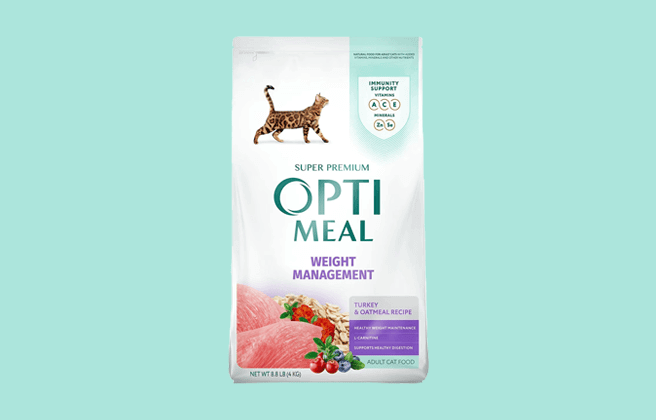
Optimeal Turkey & Oatmeal Recipe Weight Management Adult Cats received the Cat Food Advisor’s second highest rating: 4 stars.
It is one of eight recipes in this product range made by Optimeal.
Optimeal Turkey & oatmeal recipe weight management adult cats recipe derives the bulk of its protein from Turkey.
Dry matter label analysis reveals a wet recipe containing 34% protein, 11% fat and 47.1% carbohydrates . . . with a fat-to-protein ratio of 32%.
This food provides cats with an excellent source of quality protein and animal fats, made with natural, wholesome ingredients, free from carrageenan and artificial colors.
Recommended.
Read our review of the full Optimeal (Dry) range hereThings we like
- Good quality protein
- Contains species appropriate animal fats
- No artificial colors and preservatives
Main Ingredients Deboned turkey, oats, rice, chicken meal & turkey meal. Texture Dry Type Kibble Protein Percentage 34% AAFCO Standards Maintenance Best For Senior and adult cats Save up to 35%
with Autoship
See discount in cartSample buyer review...
"My cat is an incredibly picky eater, and even she liked this food. She is usually the type of feline who turns her nose up at anything that doesn't smell like her regular diet, yet she was willing to give this a try. And she ate it. And kept eating it until the bag was empty. That earns this food a rousing endorsement from me!"
-
Blue Buffalo True Solutions (Dry)
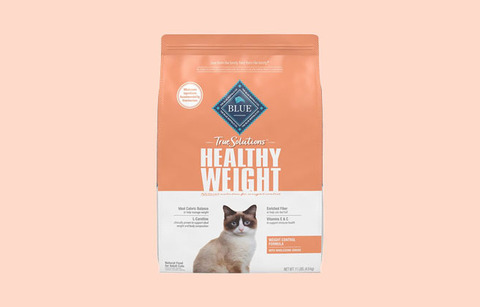
Blue Buffalo True Solutions Adult Cat – Fit & Healthy Weight Control Formula received the Cat Food Advisor’s highest rating: 5 stars.
It is one of four recipes in a product range made by General Mills. Blue Buffalo True Solutions dry cat foods is created by PhD animal nutritionists and veterinarians.
This Fit & Healthy Weight Control Formula derives the bulk of its protein from chicken. Dry matter label analysis reveals a wet recipe containing 39.6% protein, 13.2% fat and 39.3% carbohydrates . . . with a fat-to-protein ratio of 33%.
It is made from high-quality natural ingredients including real chicken and has no artificial flavors or preservatives.
Highly recommended.
Read our review of the full Blue Buffalo True Solutions (Dry) range hereThings we like
- Real meat as the main ingredient
- Different recipes for health concerns
- No artificial additives or animal by-products
Main Ingredients Deboned chicken, chicken meal, pea protein, barley Texture Dry Type Kibble Protein Percentage 39.6% AAFCO Standards Maintenance Best For Cats & senior cats Save up to 35%
with Autoship
See discount in cartSample buyer review...
"My cat loves the True Solutions Healthy Weight Control Chicken flavor"
-
Tiki Cat Born Carnivore (Dry)
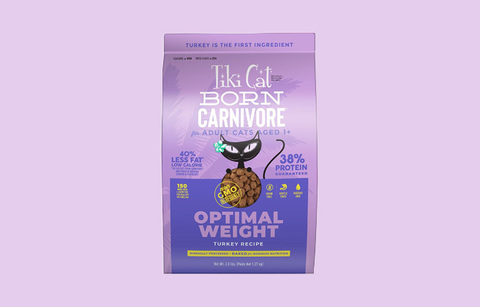
Tiki Cat Born Carnivore Optimal Weight Turkey Recipe received the Cat Food Advisor’s second highest rating: 4.5 stars.
It is one of eight recipes in a product range made by Tiki Cat and is rich in protein and low carbohydrate content. It is formulated with a focus on providing a high-protein diet that mimics a cat’s natural carnivorous diet.
This Optimal Weight Turkey recipe derives the bulk of its protein from turkey, which is naturally rich in the 11 essential amino acids required by a cat to sustain life. Dry matter label analysis reveals a wet recipe containing 42.2% protein, 12.2% fat and 37.6% carbohydrates . . . with a fat-to-protein ratio of 29%.
Tiki Cat Born Carnivore dry cat food uses real, animal-based proteins as the primary ingredients. These proteins typically include chicken, fish, or other meat sources.
Highly recommended.
Read our review of the full Tiki Cat Born Carnivore (Dry) range hereThings we like
- Non-GMO ingredients
- High in protein
- No artificial additives
Main Ingredients Deboned turkey, chicken meal, peas, dehydrated chicken, powdered cellulose Texture Dry Type Kibble Protein Percentage 42.2% AAFCO Standards Maintenance Best For Senior and adult cats Save up to 35%
with Autoship
See discount in cartSample buyer review...
"Needed a lower fat option for one of my cats. She was on Tiki Cat Indoor and liked that one, so the transition has been easy, so far, mixing half and half at this point. Hopefully this will help her lose a pound or two. As always, great healthy ingredients with Tiki Cat."
-
Halo Holistic (Dry)
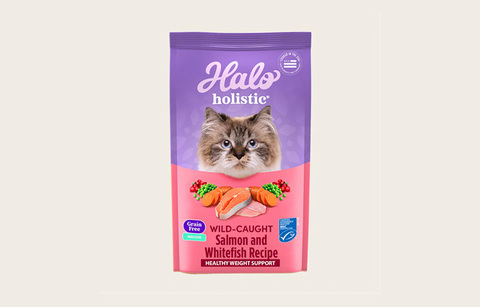
Halo Holistic Wild-Caught Salmon Whitefish Indoor Cat Food (Healthy Weight Support) recipe received the Cat Food Advisor’s highest rating: 5 stars.
It is one of seven recipes in this dry product range made by Halo and does not include corn, wheat, wheat gluten or rice.
Halo Holistic Wild-Caught Salmon Whitefish Indoor Cat Food (Healthy Weight Support) recipe derives the bulk of its protein from salmon.
Dry matter label analysis reveals a wet recipe containing 36.3% protein, 13.2% fat and 42.5% carbohydrates . . . with a fat-to-protein ratio of 36%.
Halo stands out with a commitment to sustainable ingredient sourcing. It does not use rendered meats or meat by-products. None of the recipes contain artificial colors, flavors, or preservatives.
Highly recommended.
Read our review of the full Halo Holistic (Dry) range hereThings we like
- Contains fish
- High protein
- Free from artificial colors, flavors and preservatives
Main Ingredients Salmon, whitefish, oats, pork, pea Texture Dry Type Kibble Protein Percentage 36.3% AAFCO Standards Maintenance Best For Adult and Senior cats Save up to 35%
with Autoship
See discount in cartSample buyer review...
"If you are a label reader and value quality ingredients for your fur babies and yourself - this is a near perfect product. My fussy kitties love it."
-
Nulo MedalSeries (Dry)
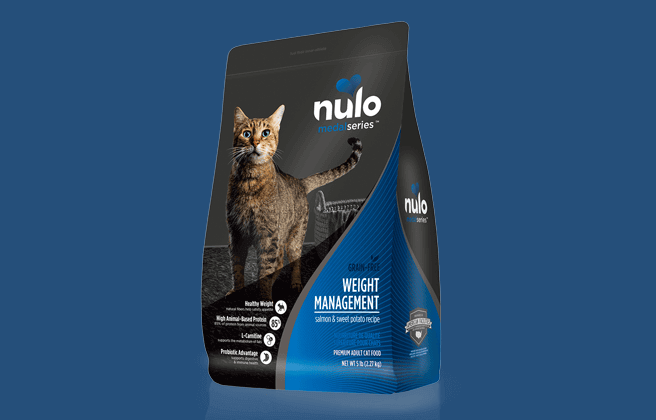
Nulo MedalSeries High Protein Kibble Weight Management Salmon & Sweet Potato cat food received the Cat Food Advisor’s second highest rating: 4 stars.
It is one of 15 recipes in this product range made by Nulo Pet Food, which was founded in 2009 and still privately owned today. All ingredients are sourced and recipes made in the USA.
Nulo MedalSeries High Protein Kibble Weight Management Salmon & Sweet Potato derives the bulk of its protein from salmon, an oily marine and freshwater fish not only high in protein but also omega 3 fatty acids, essential oils needed by every cat to sustain life.
Dry matter label analysis reveals a wet recipe containing 44.3% protein, 13.3% fat and 34.2% carbohydrates . . . with a fat-to-protein ratio of 30%.
It is formulated to meet the nutritional levels established by AAFCO cat food nutrient profiles for adult and senior cat maintenance.
Highly recommended.
Read our review of the full Nulo MedalSeries (Dry) range hereThings we like
- Contains omega-3s
- Contains probiotics
- Grain-free
Main Ingredients Deboned salmon, turkey meal, chicken meal, dried sweet potatoes, deboned cod Texture Dry Type Kibble Protein Percentage 44.4% AAFCO Standards Maintenance Best For Cats & senior cats Sample buyer review...
"I used to use the lentil and duck recipe which my three cats adored but two started putting on some indoor weight. I found weight management and they like it just as much and they've both lost weight! Vet is happy!"
Best cat foods
Why should you not overfeed your cat?
It is important not to overfeed your cat for several reasons:
Obesity: Overfeeding can lead to obesity in cats, this can then result in an increase in the risk of various health problems such as diabetes, heart disease, arthritis and respiratory issues. It can reduce their overall quality of life and also shorten a cat’s lifespan.
Reduced Lifespan: Obesity is associated with various health complications that can negatively impact a cat’s overall well-being and longevity. Obese cats often have shorter lifespans compared to cats that maintain a healthy weight.
Decreased Quality of Life: Decreased mobility can cause difficulty in grooming and increased susceptibility to various health issues, your cat can then experience a reduced quality of life. Their overall happiness and well-being is impacted because they are less active, less playful and more lethargic.
Financial Burden: Frequent veterinary visits, medication, specialized diets, and potential treatments for obesity-related conditions can put a financial strain on cat owners.
What should you do if your cat is overweight?
To ensure the health and well-being of your cat, it’s important to provide them with a balanced and appropriate diet and monitor their food intake.
Determining the right amount to feed your cat depends on various factors, including their age, weight, activity level, metabolism, and any specific dietary requirements or health conditions they may have.
Here are some general guidelines to help you determine the right amount to feed your cat:
Read the feeding guidelines: Most commercial cat food brands provide recommended feeding guidelines on their packaging. Do remember these are just guidelines and may need to be adjusted based on your cat’s individual needs.
Consult with your veterinarian: Your veterinarian is the best resource for determining your cat’s specific dietary needs. They may consider factors such as the cat’s ideal weight, any underlying health issues, and the type of food (wet or dry) that suits your cat best and tailor feeding recommendations.
Consider your cat’s activity level: Look to adjust portion sizes accordingly to accommodate their energy levels. Outdoor cats may have a higher activity level compared to other more sedentary indoor cats.
Monitor your cat’s body condition: Regularly assess your cat’s body condition by feeling their ribs and waistline. You should be able to feel their ribs without excess fat covering, and there should be a noticeable waistline behind the ribs when viewing from above. If your cat is underweight or overweight, adjust the portion size accordingly.
Split meals into multiple servings: Consider splitting their daily food portion into several smaller meals throughout the day rather than one large meal. This helps prevent overeating and promotes better digestion.
Avoid overfeeding treats: Treats should not contribute to a significant portion of your cat’s daily calorie intake and should be given in moderation. Choose healthy, low-calorie treats or consider using portioned-out treats as part of their daily food allowance.
What health conditions can be caused by obesity in cats?
Obesity in cats can contribute to several health issues, including:
Diabetes: Overweight cats are at a higher risk of developing diabetes mellitus, a condition characterized by high blood sugar levels. Obesity affects insulin sensitivity, and the excess weight can strain the pancreas, leading to insulin resistance and an increased likelihood of diabetes.
Joint Problems: Osteoarthritis can be caused due to increased stress on joints when your cat is obese. Joint problems can cause pain, reduced mobility, and discomfort for the cat.
Heart Disease: Your cat’s cardiovascular health and overall well-being can be compromised if they are obese. Obesity in cats can contribute to heart disease, including hypertension (high blood pressure) and cardiomyopathy (disease of the heart muscle).
Respiratory Issues: Breathing difficulties can occur in obese cats particularly during physical activities and warm environments. Respiratory issues can negatively impact a cat’s overall quality of life.
Urinary Tract Problems: Obesity can contribute to the formation of urinary crystals, blockages, and bladder inflammation, leading to discomfort and potential complications. Feline lower urinary tract disease (FLUTD) is more likely in overweight cats.
Hepatic Lipidosis: Fatty liver disease, hepatic lipidosis can occur in overweight cats that experience a rapid loss of appetite or go without food for an extended period. The body’s fat stores are mobilized excessively, overwhelming the liver’s capacity to process them, resulting in liver dysfunction.
Sources
Cat Food Advisor is reader supported. If you buy using links on this page, we may earn a referral fee.
Article reviewed by
Veterinarian
Dr Georgia Jeremiah has a first class honors degree in comparative pathology with field experience in anatomic and clinical pathology, studying disease processes in a multitude of species.





